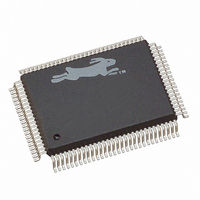20-668-0003 Rabbit Semiconductor, 20-668-0003 Datasheet - Page 8

20-668-0003
Manufacturer Part Number
20-668-0003
Description
IC CPU RABBIT2000 30MHZ 100PQFP
Manufacturer
Rabbit Semiconductor
Datasheet
1.20-668-0003.pdf
(228 pages)
Specifications of 20-668-0003
Processor Type
Rabbit 2000 8-Bit
Speed
30MHz
Voltage
2.7V, 3V, 3.3V, 5V
Mounting Type
Surface Mount
Package / Case
100-MQFP, 100-PQFP
Data Bus Width
8 bit
Maximum Clock Frequency
30 MHz
Operating Supply Voltage
0 V to 5.5 V
Maximum Operating Temperature
+ 85 C
Mounting Style
SMD/SMT
Minimum Operating Temperature
- 40 C
Number Of Programmable I/os
40
Number Of Timers
8 & 10 bit
Lead Free Status / RoHS Status
Lead free / RoHS Compliant
Features
-
Lead Free Status / Rohs Status
Lead free / RoHS Compliant
Other names
20-668-0003
316-1062
316-1062
Available stocks
Company
Part Number
Manufacturer
Quantity
Price
Company:
Part Number:
20-668-0003
Manufacturer:
Rabbit Semiconductor
Quantity:
10 000
- Current page: 8 of 228
- Download datasheet (2Mb)
• Access to I/O devices is accomplished by using memory access instructions with an I/O
• The hardware design rules are simple. Up to six static memory chips (such as RAM and
• The Rabbit may be cold-booted via a serial port or the parallel access slave port. This
• There are 40 parallel I/O lines (shared with serial ports). Some I/O lines are timer syn-
• There are four serial ports. All four serial ports can operate asynchronously in a variety
• A slave port allows the Rabbit to be used as an intelligent peripheral device slaved to a
• The built-in battery-backable time/date clock uses an external 32.768 kHz crystal. The
• Numerous timers and counters (six all together) can be used to generate interrupts,
2
prefix. Access to I/O devices is thus faster and easier compared to processors with a
restricted I/O instruction set.
flash EPROM) connect directly to the microprocessor with no glue logic. Even larger
amounts of memory can be handled by using parallel I/O lines as high-order address
lines. The Rabbit runs with no wait states at 24 MHz with a memory having an access
time of 70 ns. There are two clocks per memory access. Most I/O devices may be con-
nected without glue logic.
The memory cycle is two clocks long. A clean memory and I/O cycle completely avoid
the possibility of tri-state fights. Peripheral I/O devices can usually be interfaced in a
glueless fashion using pins programmable as I/O chip selects, I/O read strobes or I/O
write strobe pins. A built-in clock doubler allows ½-frequency crystals to be used to
reduce radiated emissions.
means that flash program memory may be soldered in unprogrammed, and can be
reprogrammed at any time without any assumption of an existing program or BIOS. A
Rabbit that is slaved to a master processor can operate entirely with volatile RAM,
depending on the master for a cold program boot.
chronized, which permits precisely timed edges and pulses to be generated under com-
bined hardware and software control.
of customary operating modes; two of the ports can also be operated synchronously to
interface with serial I/O devices. The baud rates can be very high—1/32 the clock
speed for asynchronous operation, and 1/6 the clock speed externally or 1/4 the clock
speed internally in synchronous mode. In asynchronous mode, the Rabbit, like the
Z180, supports sending flagged bytes to mark the start of a message frame. The flagged
bytes have 9 data bits rather than 8 data bits; the extra bit is located after the first 8 bits,
where the stop bit is normally located, and marks the start of a message frame.
master processor. The 8-bit slave port has six 8-bit registers, 3 for each direction of
communication. Independent strobes and interrupts are used to control the slave port in
both directions. Only a Rabbit and a RAM chip are needed to construct a complete
slave system if the clock and reset are shared with the master processor
time/date clock can also be used to provide periodic interrupts every 488 µs. Typical
battery current consumption is 25 µA with the suggested battery circuit. An alternative
circuit provides means for substantially reducing this current.
baud rate clocks, and timing for pulse generation.
Rabbit 2000 Microprocessor User’s Manual
Related parts for 20-668-0003
Image
Part Number
Description
Manufacturer
Datasheet
Request
R

Part Number:
Description:
IC CPU RABBIT4000 128-LQFP
Manufacturer:
Rabbit Semiconductor
Datasheet:

Part Number:
Description:
IC MPU RABIT3000A 55.5MHZ128LQFP
Manufacturer:
Rabbit Semiconductor
Datasheet:

Part Number:
Description:
Microprocessors - MPU Rabbit 3000 TFBGA Microprocessor
Manufacturer:
Rabbit Semiconductor

Part Number:
Description:
Microprocessors - MPU Rabbit 4000 LQFP Microprocessor
Manufacturer:
Rabbit Semiconductor

Part Number:
Description:
IC, I/O EXPANDER, 8BIT, 40MHZ, TQFP-64
Manufacturer:
Rabbit Semiconductor

Part Number:
Description:
SCRs 1.5A 200uA 400V Sensing
Manufacturer:
Littelfuse Inc
Datasheet:

Part Number:
Description:
CARD 6-RELAY SMARTSTAR SR9500
Manufacturer:
Rabbit Semiconductor
Datasheet:

Part Number:
Description:
WIRE-BOARD CONN RECEPTACLE, 6POS, 3.96MM
Manufacturer:
TE Connectivity
Datasheet:

Part Number:
Description:
ADAPTER 20 PIN .420" PLUGS(6PCS)
Manufacturer:
Logical Systems Inc.
Datasheet:

Part Number:
Description:
CONN BARRIER BLOCK .438" 20 POS
Manufacturer:
Cinch Connectors
Datasheet:

Part Number:
Description:
20 MODII 2PC HDR DR SHRD, ROHS
Manufacturer:
TE Connectivity
Datasheet:

Part Number:
Description:
WIRE-BOARD CONN RECEPTACLE, 6POS, 3.96MM
Manufacturer:
TE Connectivity
Datasheet:














